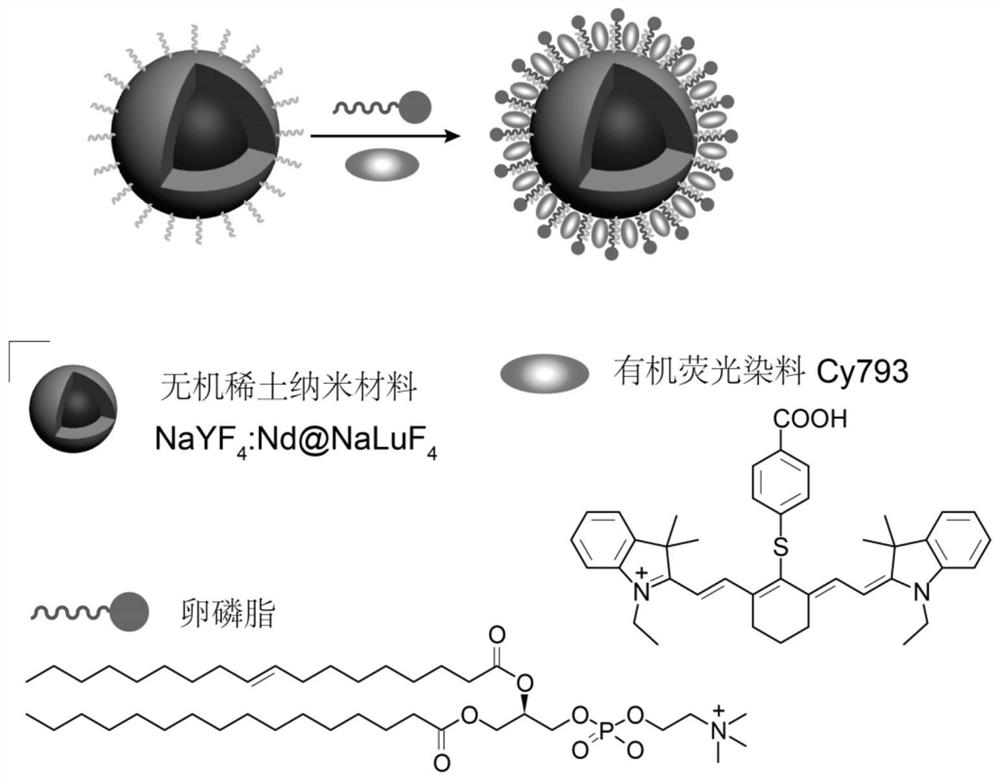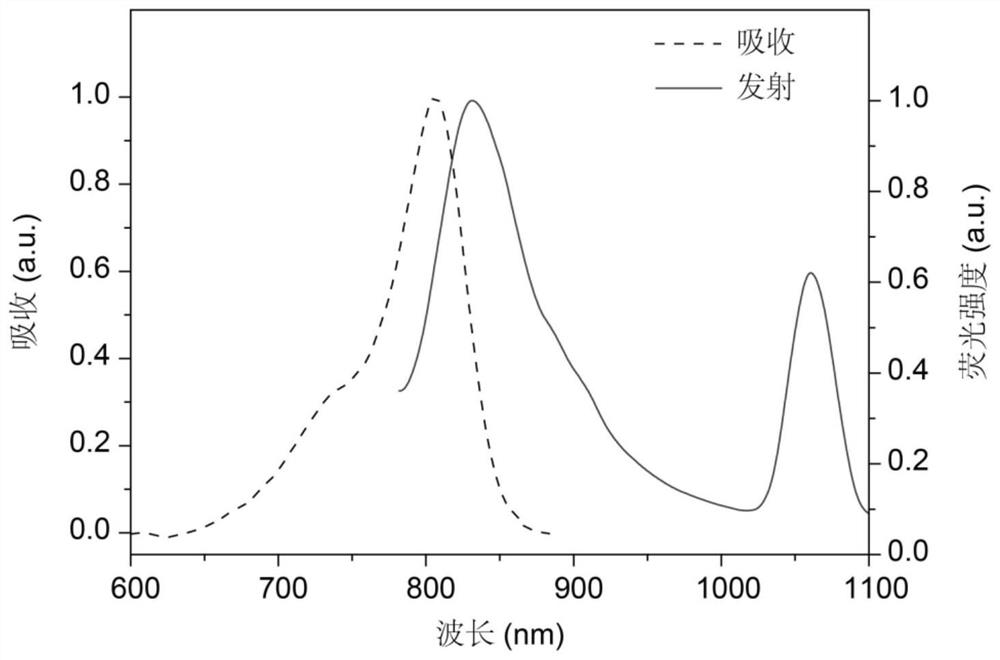A composite nanoprobe and its method for in vivo ratiometric imaging detection
A nanoprobe and living body technology, applied in the field of nanoprobes, can solve the problems of reducing the penetration depth and limitations of fluorescence imaging, and achieve the effects of overcoming uneven distribution, reducing interference, and improving imaging signal-to-noise ratio
- Summary
- Abstract
- Description
- Claims
- Application Information
AI Technical Summary
Problems solved by technology
Method used
Image
Examples
Embodiment 1
[0039] Example 1 Preparation of Responsive Composite Nanoprobes
[0040] (1) Preparation of mercury ion-responsive composite nanoprobes
[0041] In the composite nanoprobe in this embodiment, the organic fluorescent dye used is a rhodamine dye (FUC-1) that is responsive to mercury ions, and the inorganic rare earth nanomaterial used is NaYF with a core-shell structure. 4 :Nd@NaYF 4 , select amphiphilic polymer (F127) for self-assembly, and finally form a water-soluble composite nanoprobe responsive to mercury ions.
[0042] (2) Preparation of nitroreductase-responsive composite nanoprobes
[0043] In the composite nanoprobe in this example, the organic fluorescent dye used is a cyanine dye (Cy7-1) responsive to nitroreductase, and the inorganic rare earth nanomaterial used is NaYF 4 :Nd, choose silica for self-assembly, and finally form a water-soluble composite nanoprobe responsive to nitroreductase.
[0044] (3) Preparation of hypochlorous acid-responsive composite nanop...
Embodiment 2
[0047] Example 2 Photophysical Properties and Responsiveness of Composite Nanoprobes
[0048] (1) Mercury ion responsiveness research
[0049] The composite nanoprobe prepared in Example 1(1) was dispersed in an aqueous solution, and the ultraviolet absorption and fluorescence emission spectra were tested. Under 808nm excitation, the composite probe has a near-infrared emission peak at 1060nm, which can be attributed to the inorganic rare earth nanomaterial Nd 3+ feature emission. After adding mercury ions to the aqueous solution, the emission peak at 1060nm did not change, but a new near-infrared emission appeared at 730nm, and showed a trend of increasing gradually with the addition of mercury ions. This peak can be attributed to the frequency up-conversion emission generated by the reaction of the organic fluorescent dye FUC-1 with mercury ions.
[0050] (2) Study on the responsiveness of nitroreductase
[0051] The composite nanoprobe prepared in Example 1(2) was dispe...
Embodiment 3
[0055] Example 3 Composite nanoprobes for ratiometric imaging in vivo
[0056] (1) In vivo mercury ion ratio imaging
[0057] The composite nanoprobe prepared in Example 1(1) was dispersed in phosphate buffer solution, injected into mercury poisoning model mice and control mice 0.2 mL through the tail vein, and optically imaged on an in vivo imager after anesthesia. Using 808nm laser as the excitation light source, when the emitted light with a wavelength of 730±20nm is collected, the signal in the liver of the mercury poisoning model mice is significantly stronger than that of the control group mice, and the signal is attributed to the organic fluorescent dye FUC-1 and mercury ions The emission peak generated after the action verified the responsiveness of the composite nanoprobe to excess mercury ions in the liver of mercury poisoning model mice. When collecting the emission signal with a wavelength of 1060±20nm, the intensity of the two groups is equivalent, and the signal...
PUM
| Property | Measurement | Unit |
|---|---|---|
| size | aaaaa | aaaaa |
| thickness | aaaaa | aaaaa |
Abstract
Description
Claims
Application Information
 Login to View More
Login to View More - R&D
- Intellectual Property
- Life Sciences
- Materials
- Tech Scout
- Unparalleled Data Quality
- Higher Quality Content
- 60% Fewer Hallucinations
Browse by: Latest US Patents, China's latest patents, Technical Efficacy Thesaurus, Application Domain, Technology Topic, Popular Technical Reports.
© 2025 PatSnap. All rights reserved.Legal|Privacy policy|Modern Slavery Act Transparency Statement|Sitemap|About US| Contact US: help@patsnap.com



